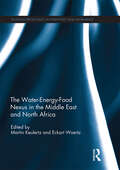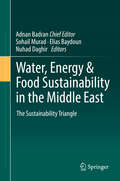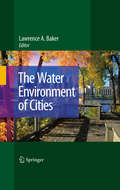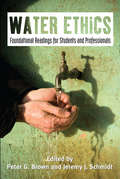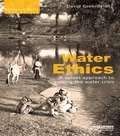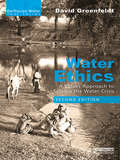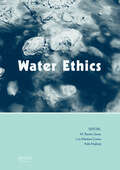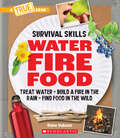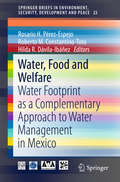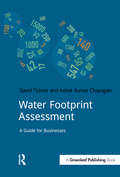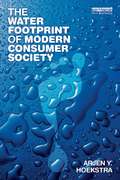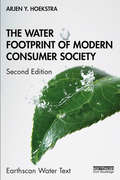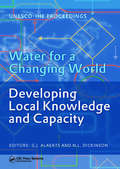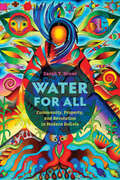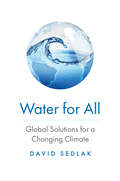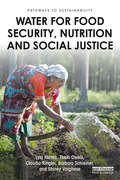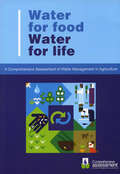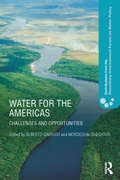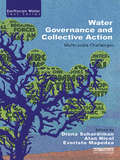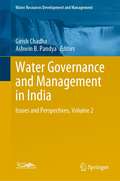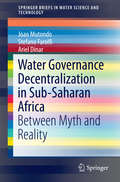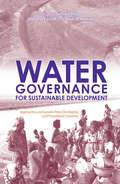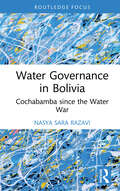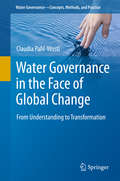- Table View
- List View
The Water-Energy-Food Nexus in the Middle East and North Africa (Routledge Special Issues on Water Policy and Governance)
by Martin Keulertz Eckart WoertzThis book discusses key issues concerning water, energy and food in the Middle East and North Africa (MENA) region. It provides an interdisciplinary account of current developments in the most water-scarce and conflict-torn region in the world. Key analysts on MENA water, agriculture and energy affairs have been drawn together to compile one of the first edited volumes dedicated to the crucial role of water, energy and food security in the 21st century MENA region. It will be of interest to decision-makers, analysts and students of the future of the Middle East from a broad range of disciplines including the physical and social sciences. This book was previously published as a special issue of the International Journal of Water Resources Development.
Water, Energy & Food Sustainability in the Middle East
by Sohail Murad Elias Baydoun Nuhad DaghirThis book provides a survey of technologies available to tackle the problems associated with climate change in the energy, water and food security nexus with a special focus on the Middle East. It is divided into three main sections. The energy Section consists of six chapters, the water section of seven chapters and finally the food security section has six chapters. The individual chapters are authored by experts and provide discussions and in-depth views on the current status of each topic.
The Water Environment of Cities
by Lawrence A. BakerUrbanization of the Earth's population will have increased the Earth's urban population from less than one billion in 1950 to five billion by 2030. Managing water for this burgeoning urban population is one of the critical needs for humanity. This book uses a holistic, interdisciplinary approach to examine the urban water environment. Water has multiple roles: municipal water supply, aquatic habitat, landscape aesthetics and recreation. Increasingly, urban water is reused, serving multiple purposes. Humans alter the urban hydrologic cycle and the chemical and physical integrity of urban water systems and resources. Some of those changes are beneficial, and others harmful. Understanding those changes and impacts requires expertise and perspective from a wide range of disciplines. Chapter authors represent this diversity of expertise, with expertise in surface and groundwater hydrology, civil and environmental engineering, environmental policy, urban planning, law, geomorphology, and recreation management.
Water Ethics: Foundational Readings for Students and Professionals
by Peter G. Brown Jeremy J. SchmidtHaving manipulated water for irrigation, energy, and burgeoning urban centers, humans are facing the reality that although fresh water is renewable, it is as finite as any other resource. Countries, states, and cities are now scrambling to develop an intelligent, well-informed approach to mitigate the growing global water crisis. Water Ethics is based on the belief that responding to contemporary water problems requires attending to questions of value and culture. How should we capture, store, and distribute water? At what cost? For whom? How do we reconcile water's dual roles as a practical resource and spiritual symbol? According to the editors of this collection of foundational essays, questions surrounding water are inherently ethical. Peter Brown and Jeremy Schmidt contend that all approaches to managing water, no matter how grounded in empirical data, involve value judgments and cultural assumptions. Each of the six sections of the book discuses a different approach to thinking about the relationship between water and humanity, from utilitarianism to eco-feminism to religious beliefs, including Islam, Hinduism, and Christianity. Contributors range from Bartholemew, Ecumenical Patriarch of the Orthodox Church to Nobel Laureate economist Elinor Ostrom and water policy expert Sandra Postel. Each section is framed by an original introductory essay written by the editors. Water Ethics will help readers understand how various moral perspectives, even when unstated, have guided and will continue to guide water policy around the globe.
Water Ethics: A Values Approach to Solving the Water Crisis
by David GroenfeldtThis book introduces the idea that ethics are an intrinsic dimension of any water policy, program, or practice, and that understanding what ethics are being acted out in water policies is fundamental to an understanding of water resource management. Thus in controversies or conflicts over water resource allocation and use, an examination of ethics can help clarify the positions of conflicting parties as preparation for constructive negotiations. The author shows the benefits of exposing tacit values and motivations and subjecting these to explicit public scrutiny where the values themselves can be debated. The aim of such a process is to create the proverbial 'level playing field', where values favoring environmental sustainability are considered in relation to values favoring short-term exploitation for quick economic stimulus (the current problem) or quick protection from water disasters (through infrastructure which science suggests is not sustainable). The book shows how new technologies, such as drip irrigation, or governance structures, such as river basin organizations are neither "good" nor "bad" in their own right, but can serve a range of interests which are guided by ethics. A new ethic of coexistence and synergies with nature is possible, but ultimately depends not on science, law, or finances but on the values we choose to adopt. The book includes a wide range of case studies from countries including Australia, India, Philippines, South Africa and USA. These cover various contexts including water for agriculture, urban, domestic and industrial use, the rights of indigenous people and river, watershed and ecosystem management.
Water Ethics: A Values Approach to Solving the Water Crisis (Earthscan Water Text)
by David GroenfeldtFully revised and updated, this second edition of Water Ethics continues to consolidate water ethics as a key dimension of water-related decisions. The book introduces the idea that ethics are an intrinsic dimension of any water policy, program, or practice, and that understanding what ethics are being acted out in water policies is fundamental to an understanding of water resource management. Alongside updated references and the introduction of discussion questions and recommended further reading, this new edition discusses in depth three significant developments since the publication of the first edition in 2013. The first is the growing awareness of the climate crisis as an existential threat, and associated concern about adaptive strategies for sustainable water management and ways of using water management for climate mitigation (e.g., practically through agricultural soil management and conceptually through ethics awareness). Second, there has been increased clarity among the religious community, Indigenous leaders, and progressive academics that ethics needs to become an arena for application and action (e.g., the Vatican encyclical Laudato Si, protests at Standing Rock and Flint, Michigan, in the US, and climate demonstrations worldwide). Thirdly, there have been new normative water standards ranging from "water stewardship" (industry initiative), water charters (Berlin) and the on-going initiative to develop a global water ethics charter. Drawing on case studies from countries including Australia, India, the Philippines, South Africa, and the United States, this textbook is essential reading for students of environmental ethics and water governance and management.
Water Ethics: Marcelino Botin Water Forum 2007
by M. Ramón Llamas Luis Martínez-Cortina Aditi MukherjiIn the context of the current financial crisis, and at a time of deep global change, growing attention is paid to the global norms and ethical values that could underpin future global policy. Water is a key global resource. At the 3rd Marcelino Botin Foundation Water Workshop, held in Santander, Spain, June 12-14, 2007, the role of ethics in the de
Water, Fire, Food: Treat Water, Build a Fire in the Rain, Find Food in the Wild (A True Book (Relaunch))
by Diane VukovicLearn basic survival skills and connect with nature!Knowing how to find safe drinking water, how to build a fire, and which foods are safe to eat — as well as which are not — are skills that every outdoor adventurer needs. Did you know that you can find edible plants right in your own backyard? Or that certain insects are super nutritious? Learn all this and more in Food, Water, and Fire—a book that gives kids the confidence they need to get outside and explore.ABOUT THE SERIES:Learning basic survival skills will give every kid the confidence — and the know-how — to handle emergencies and extreme situations. It also helps them feel comfortable and secure when they’re connecting with the outdoors while hiking, backpacking, or simply exploring the woods. The books in the Survival Skills series teach kids how to build a shelter from found materials, how to navigate (even without a compass), how to treat injuries in case of emergency, and so much more. These essential skills will give them the tools to take care of themselves in any situation.
Water, Food and Welfare
by Rosario Pérez-Espejo Roberto M. Constantino-Toto Hilda R. Dávila-IbáñezThis book addresses the following topics: the contemporary model for water management and alternative approaches; the socioeconomic framework, water policy and institutions; water use for food purposes, water-resources inventory and irrigation; manifestations of welfare loss and water prices; change in dietary patterns and water security; hydrological stress and pressures on water availability; groundwater management problems; vulnerability and climate change; water demand of major crops; gray water footprint and water pollution; gray water footprint and mining; virtual water and food trade; estimates of the water footprint of four key cereals, forage, livestock and bottled drinks. It is the result of a cooperation between 16 researchers from eleven Mexican academic institutions.
Water Footprint Assessment: A Guide for Business (Doshorts Ser.)
by David Tickner Ashok Kumar ChapagainAs business risks associated with water intensify – for example risks to oeprations, supply chains and reputation – many corporate sustainability professionals are seeking practical tools to help them understand and assess these risks. Water Footprint Assessment tools developed primarily by the research sector are gaining attention in this context. However, there is debate among experts and non-experts about the merits of this approach. Water Footprint Assessment: A Business Guide is a concise and comprehensive digest of emerging concepts, tools and arguments around water footprint approaches. Specifically aimed at business audiences, this definitive short guide to the issues distils the latest in scientific and policy literature, helps sustainability leaders understand what they can, and can't do with water footprint tools, includes practical experience and case studies and outlines the pros and cons of using Water Footprint Assessment and similar approaches.
The Water Footprint of Modern Consumer Society
by Arjen Y. HoekstraWater is not only used in the domestic context, but also in agriculture and industry in the production of commercial goods, from food to paper. The water footprint is an indicator of freshwater use that looks at both direct and indirect use of water by a consumer or producer. The water footprint of an individual, community or business is defined as the total volume of freshwater that is used to produce the goods and services consumed by the individual or community or produced by the business. This book shows how the water footprint concept can be used to quantify and map the water use behind consumption and how it can guide reduction of water use to a sustainable level. With a number of case studies, it illustrates water use along supply chains and that water consumption at one place is often linked to water use at another. For example, it is calculated that it takes 15,000 litres of water to produce 1 kg of beef, or 8,000 litres of water to produce a pair of jeans. The book shows that imports of water-intensive products can highly benefit water-scarce countries, but also that this creates a dependency on foreign water resources. The book demonstrates how water-scarce regions sometimes, nevertheless, use lots of water for making export products. It raises the issue of sustainable consumption: how can consumers, businesses and governments get involved in reducing the water footprints of final consumer goods?
The Water Footprint of Modern Consumer Society (Earthscan Water Text)
by Arjen Y. HoekstraUsing the water footprint concept, this impactful book aids our understanding of how we can reduce water consumption and pollution to sustainable levels. Since the publication of the first edition, the question of how to reduce our water footprint has become even more urgent. Freshwater scarcity is increasingly perceived as a global systemic risk and overconsumption of water is widespread. The water footprint, a concept founded by the author, is an indicator of direct and indirect freshwater use by a consumer or producer that can be used to analyze water usage along supply chains and assess the sustainability, efficiency and fairness of our water use. This new edition is fully revised and updated to reflect continued developments in this rapidly growing field of knowledge. New chapters are added covering the history of the water footprint concept; the environmental footprint of the human species versus planetary boundaries; and the human right to water as a foundation to equitable sharing. All other chapters are fully revised with new findings, applications and references, including major new research on energy, vegetarian diets and intelligent water allocation over competing demands. The Water Footprint of Modern Consumer Society is a key textbook for students of interdisciplinary water studies and those taking other related courses within the environmental sciences. It will also be of interest to those working in the governmental sector, environmental and consumer organizations, the business sector and UN institutions, where there is growing interest in the water footprint concept.
Water for a Changing World - Developing Local Knowledge and Capacity: Proceedings of the International Symposium "Water for a Changing World Developing Local Knowledge and Capacity", Delft, The Netherlands, June 13-15, 2007
by G. J. Alaerts N. L. DickinsonThis collection of papers represents the outcomes of the International Symposiumheld in Delft, The Netherlands, on June 13-15, 2007, at the occasion of the 50thanniversary of the UNESCO-IHE Institute for Water Education. The papers discusshow to contribute to the sustainability of effective international development andwater management with a diges
Water for All: Community, Property, and Revolution in Modern Bolivia
by Sarah T. HinesWater for All chronicles how Bolivians democratized water access, focusing on the Cochabamba region, which is known for acute water scarcity and explosive water protests. Sarah T. Hines examines conflict and compromises over water from the 1870s to the 2010s, showing how communities of water users increased supply and extended distribution through collective labor and social struggle. Analyzing a wide variety of sources, from agrarian reform case records to oral history interviews, Hines investigates how water dispossession in the late nineteenth century and reclaimed water access in the twentieth and twenty-first centuries prompted, shaped, and strengthened popular and indigenous social movements. The struggle for democratic control over water culminated in the successful 2000 Water War, a decisive turning point for Bolivian politics. This story offers lessons for contemporary resource management and grassroots movements about how humans can build equitable, democratic, and sustainable resource systems in the Andes, Latin America, and beyond.
Water for All: Global Solutions for a Changing Climate
by David SedlakA fresh look at the world&’s water crises, and the existing and emerging solutions that can be used to solve them It is not your imagination: water crises are more frequent. Our twentieth-century systems for providing the water that grows food, sustains cities, and supports healthy ecosystems are failing to meet the demands of growing population and the challenges brought on by climate change. But the grim news reports—of empty reservoirs, withering crops, failing ecosystems—need not be cause for despair, argues award-winning author David Sedlak. Communities on the front lines of previous water crises have pioneered approaches that are ready to be applied elsewhere. Some have resolved shortages by enhancing water-use efficiency, and others have used moments of crisis to resolve historic disagreements over water rights. Still others have employed treatment technologies that unlock vast quantities of untapped water resources. Sedlak identifies the challenges that society faces, including ineffective policies and outdated infrastructure, and the myriad of tools at our disposal—from emerging technologies in desalination to innovations for recycling wastewater and capturing more of the water that falls on fields and cities. He offers an informed and hopeful approach for rethinking our assumptions about the way that water is managed. With this knowledge we can create a future with clean, abundant, and affordable water for all.
Water for Food Security, Nutrition and Social Justice (Pathways to Sustainability)
by Lyla Mehta Theib Oweis Claudia Ringler Barbara Schreiner Shiney VargheseThis book is the first comprehensive effort to bring together Water, Food Security and Nutrition (FSN) in a way that goes beyond the traditional focus on irrigated agriculture. Apart from looking at the role of water and sanitation for human well-being, it proposes alternative and more locally appropriate ways to address complex water management and governance challenges from the local to global levels against a backdrop of growing uncertainties. The authors challenge mainstream supply-oriented and neo-Malthusian visions that argue for the need to increase the land area under irrigation in order to feed the world’s growing population. Instead, they argue for a reframing of the debate concerning production processes, waste, food consumption and dietary patterns whilst proposing alternative strategies to improve water and land productivity, putting the interests of marginalized and disenfranchized groups upfront. The book highlights how accessing water for FSN can be challenging for small-holders, vulnerable and marginalized women and men, and how water allocation systems and reform processes can negatively affect local people’s informal rights. The book argues for the need to improve policy coherence across water, land and food and is original in making a case for strengthening the relationship between the human rights to water and food, especially for marginalized women and men. It will be of great interest to practitioners, students and researchers working on water and food issues.
Water for Food Water for Life: A Comprehensive Assessment of Water Management in Agriculture
by David MoldenManaging water resources is one of the most pressing challenges of our times - fundamental to how we feed 2 billion more people in coming decades, eliminate poverty, and reverse ecosystem degradation. This Comprehensive Assessment of Water Management in Agriculture, involving more than 700 leading specialists, evaluates current thinking on water and its interplay with agriculture to help chart the way forward. It offers actions for water management and water policy - to ensure more equitable and effective use. This assessment describes key water-food-environment trends that influence our lives today and uses scenarios to explore the consequences of a range of potential investments. It aims to inform investors and policymakers about water and food choices in light of such crucial influences as poverty, ecosystems, governance, and productivity. It covers rainfed agriculture, irrigation, groundwater, marginal-quality water, fisheries, livestock, rice, land, and river basins. Ample tables, graphs, and references make this an invaluable work for practitioners, academics, researchers, and policymakers in water management, agriculture, conservation, and development. Published with IWMI.
Water for the Americas: Challenges and Opportunities (Contributions from the Rosenberg International Forum on Water Policy)
by Alberto Garrido Mordechai ShechterThe chapters in this volume are peer reviewed editions of the papers presented at the 7th meeting of the Rosenberg International Forum on Water Policy which was held in Buenos Aires, Argentina on November 15-17, 2010. The theme for Forum VII was Water for the Americas: Challenges and Opportunities. This Forum was unique in examining the water problems of the Americas and identifying water management experience gleaned in other parts of the world that might be useful in addressing the problems of the Americas. The sessions illustrated how the water problems of the Americas are common problems, differing only in degree from basin to basin. There was unanimity among the participants about the need for all inhabitants of the Americas to work together to ensure that everyone has access to adequate quantities of healthy water supplies and to appropriate sanitation services. This volume’s approach is to identify different responses and policies that address common issues and learn from contrasts and experiences. The value and potential that this approach affords is that it provides critical judgments about what has worked well and what needs to be done to gain a better future for the Americas’ water resources and society. Some issues covered in the volume are so pressing and urgent, chief among them is serving the unserved, that any delays putting out new facilities in many a rural areas of Central America may cost lives and reduce the outlook for children. Additionally, the volume makes clear that the outlook for the poorest and the future of hundreds of growing cities are threatened by climate change. This book looks into the future by analyzing present and relevant data and gains insight from the different developmental stages of the hemisphere.
Water Governance and Civil Society Responses in South Asia
by N. C. Narayanan S. Parasuraman Rajindra AriyabanduThis book addresses paradigm shifts in water policy and governance, and examines the role of civil society organizations in influencing public policy, while focusing on social equity and democratic participation. It illustrates a range of interesting developments in policy formulation, donor–state nexus, and interventions by civil society and voluntary organizations. The collection of articles provides a comprehensive and current narrative of the state–society relations in South Asia under neoliberal governance reforms, their implications and key responses with regard to water policies. Using case studies, it closely investigates the impact, effectiveness, drawbacks and challenges faced by voluntary organizations and social movements working at various levels in the water sector. The work will interest researchers and students of development studies, environmental studies, natural resource management, water governance, and public administration, as also water sector professionals, policymakers, civil society activists and governmental and non-governmental organizations.
Water Governance and Collective Action: Multi-scale Challenges (Earthscan Water Text)
by Diana Suhardiman Alan Nicol Everisto MapedzaCollective Action is now recognized as central to addressing the water governance challenge of delivering sustainable development and global environmental benefits. This book examines concepts and practices of collective action that have emerged in recent decades globally. Building on a Foucauldian conception of power, it provides an overview of collective action challenges involved in the sustainable management and development of global freshwater resources through case studies from Africa, South and Southeast Asia and Latin America. The case studies link community-based management of water resources with national decision-making landscapes, transboundary water governance, and global policy discussion on sustainable development, justice and water security. Power and politics are placed at the centre of collective action and water governance discourse, while addressing three core questions: how is collective action shaped by existing power structures and relationships at different scales? What are the kinds of tools and approaches that various actors can take and adopt towards more deliberative processes for collective action? And what are the anticipated outcomes for development processes, the environment and the global resource base of achieving collective action across scales?
Water Governance and Management in India: Issues and Perspectives, Volume 2 (Water Resources Development and Management)
by Girish Chadha Ashwin B. PandyaThis book, the second volume in the series, continues to raise contextual issues and presents perspectives regarding multifaceted challenges in management and governance of water in India. This volume attempts to broad base and expand the dialogue started in the first volume and would touch upon issues that need immediate discussion but have been left unattended like politics and management of groundwater, efficient utilization of water in agriculture (irrigation) and improving water use efficiency and building resilience. As in the first volume, this book presents a set of suggestions and recommendations in each chapter that can help frame policy guidelines in the country.
Water Governance Decentralization in Sub-Saharan Africa
by Joao Mutondo Stefano Farolfi Ariel DinarThis book is about the process of water management decentralization in African countries, which is seen as a means of advancing river basin management at the lowest appropriate level. There are very different stages of implementing decentralization in practice. This called for research aiming to understand the following questions: (i) why do some water agencies succeed more than others? (ii) What are the variables involved in such reform process? (iii) which variables have a positive or a negative impact on the implementation of decentralization processes? (iv) Which variables could be affected by policy interventions, and how? This study aimed to answer these questions through the following objectives: (i) analyze the factors that have potentially affected the results of decentralization process in SSA basins, and (ii) analyze the performance of decentralization process in SSA basins. Qualitative and quantitative approaches were used. The main findings are that water scarcity is a major stimulus to reform; water user associations, if not well prepared and trained, may deter the decentralization process; and being part of an existing treaty over an international basin helps foster the process. Conditions improving decentralization performance include: scarcity of water resources, longer period of implementation, bottom-up creation, and appropriate budgetary support.
Water Governance for Sustainable Development: Approaches and Lessons from Developing and Transitional Countries
by Stefano FarolfiGood management of water resources - universally identified as a key aspect of poverty reduction, agriculture and food security - has proven, in practice, as difficult to achieve as it is eagerly sought. This book, edited and authored by leading authorities on water resource management, examines the recent changes in governance, institutions, economics and policies of water, covering developing, transitional and developed countries, with special emphasis on southern African case studies. The book examines how water policies, institutions and governance have shifted in recent years from supply-driven, quantitative, centrally controlled management to more demand-sensitive, decentralized, participatory approaches. Such a move often also implies cost recovery principles, resource allocation among competing sectors, and privatization. The case studies demonstrate that the new policies and legal frameworks have been difficult to implement and often fall short of initial expectations. Using an accessible multidisciplinary approach that integrates economics, sociology, geography and policy analysis, the book untangles the issues and presents best practices for policy- and decision-makers, governments and regulators, NGOs and user groups, service providers, and researchers. The overall aim is to show how good water governance structures can be developed and implemented for the benefit of all.
Water Governance in Bolivia: Cochabamba since the Water War (Routledge Focus on Environment and Sustainability)
by Nasya Sara RazaviThis book examines water remunicipalization in Cochabamba since the Water War, offering innovative methodological and theoretical conceptualizations of what it means to be "public," helping to move debates on water services beyond the paralyzing binary of public versus private with a focus on the contested terrain of community engagement around water services. The Cochabamba Water War of 2000 brought together city residents of all stripes to mobilize against water privatization and gain back public control of the city’s water utility. This event catapulted anti-privatization movements around the world, but two decades later, the water movement’s vision of democratic water provision remains largely unfulfilled and the city suffers from a protracted water crisis. Building a typology of participation, this book explores the difficulty in rebuilding a strong public water service in Cochabamba by analyzing the different, and often incompatible, understandings and interpretations of social control and public participation. Applying this framework to the Bolivian context, and more specifically to the water and sanitation sector in Cochabamba, the book uncovers whose interests are served, and which groups are included or excluded from decision-making and access to water. This exercise illustrates how, in their implementation, participatory practices are not linear and can be distorted or appropriated towards different ends. This book will be of great interest to students and scholars of water governance, natural resource management, public policy, social movements and Latin American studies.
Water Governance in the Face of Global Change
by Claudia Pahl-WostlThis book offers the first comprehensive treatment of multi-level water governance, developing a conceptual and analytical framework that captures the complexity of real water governance systems while also introducing different approaches to comparative analysis. Applications illustrate how the ostensibly conflicting goals of deriving general principles and of taking context-specific factors into account can be reconciled. Specific emphasis is given to governance reform, adaptive and transformative capacity and multi-level societal learning. The sustainable management of global water resources is one of the most pressing environmental challenges of the 21st century. Many problems and barriers to improvement can be attributed to failures in governance rather than the resource base itself. At the same time our understanding of complex water governance systems largely remains limited and fragmented. The book offers an invaluable resource for all researchers working on water governance topics and for practitioners dealing with water governance challenges alike.
